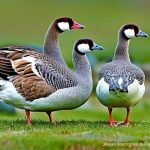Geese on docks can be a nuisance and pose potential risks and damages. It is important to keep geese away from docks to ensure the safety of both humans and the geese themselves. Geese can cause damage to docks, boats, and other structures, as well as create unsanitary conditions with their droppings. In this article, we will explore the risks and damages caused by geese on docks, common methods used to keep them away, and best practices for creating a goose-free environment.
Key Takeaways
- Geese on docks can cause damage and pose health risks to humans.
- Common methods to keep geese off docks include physical barriers, decoys, sound and light deterrents, and landscaping.
- Physical barriers, such as netting and fencing, are effective in deterring geese.
- Decoys can trick geese into thinking an area is already occupied and keep them away.
- Sound and light deterrents have limitations but can be effective when used in combination with other methods.
Understanding the Risks and Damages Caused by Geese on Docks
Geese on docks can pose several risks and cause damages that need to be addressed. One of the main risks is the potential for slips and falls. Geese are known for their droppings, which can make surfaces slippery and hazardous. This is especially dangerous on docks where people are walking, as a fall into the water can lead to drowning or other injuries.
In addition to the safety risks, geese can also cause damage to docks and boats. Their sharp beaks can peck at wood, causing structural damage over time. They may also scratch or dent boats with their claws or wings. Furthermore, their droppings can corrode metal surfaces and stain or discolor other materials.
Common Methods Used to Keep Geese off Docks
There are several common methods used to keep geese away from docks. One method is the use of physical barriers such as fencing or netting. These barriers create a physical barrier that prevents geese from accessing the dock area. While this method can be effective, it may not be aesthetically pleasing and may require regular maintenance to ensure its effectiveness.
Another method is the use of decoys, such as fake predators. These decoys trick geese into thinking that the area is unsafe, causing them to avoid it. This method can be effective, but it may require regular repositioning of the decoys to maintain their effectiveness.
The Effectiveness of Physical Barriers in Deterring Geese
Physical barriers, such as fencing and netting, can be highly effective in deterring geese from docks. These barriers create a physical barrier that prevents geese from accessing the dock area. Fencing can be installed around the perimeter of the dock, while netting can be used to cover the entire dock area.
The effectiveness of physical barriers depends on their design and installation. Fencing should be tall enough to prevent geese from flying over it and should be securely anchored to the ground to prevent geese from crawling under it. Netting should be tightly secured to prevent geese from getting tangled in it or finding gaps to enter through.
While physical barriers can be effective, they may not be aesthetically pleasing and may require regular maintenance to ensure their effectiveness. Fencing may obstruct views and access to the dock, while netting may need to be regularly checked for tears or damage.
Using Decoys to Trick Geese and Keep Them Away from Docks
Decoys, such as fake predators, can be an effective method for keeping geese away from docks. These decoys trick geese into thinking that the area is unsafe, causing them to avoid it. Common decoys include fake owls, hawks, or coyotes.
The effectiveness of decoys depends on their placement and movement. Decoys should be positioned in areas where geese are likely to land or gather, such as near the water’s edge or on nearby structures. They should also be moved regularly to maintain their effectiveness, as geese may become accustomed to their presence if they remain in the same location for too long.
While decoys can be effective, they may require regular repositioning to maintain their effectiveness. Geese may become accustomed to the presence of decoys if they remain in the same location for too long. Additionally, decoys may not be effective in all situations, as some geese may be more wary or less easily fooled by decoys.
The Benefits and Limitations of Using Sound and Light Deterrents

Sound and light deterrents can be an effective method for keeping geese away from docks. These deterrents use loud noises or bright lights to scare geese away. Common sound deterrents include propane cannons or ultrasonic devices, while light deterrents include strobe lights or lasers.
The benefits of sound and light deterrents are that they can cover a large area and can be easily adjusted to suit different situations. They can also be effective in deterring geese that are more wary or less easily fooled by physical barriers or decoys.
However, there are limitations to using sound and light deterrents. They may not be suitable for all environments, as they can be disruptive to humans or other wildlife. They may also require regular maintenance and monitoring to ensure their effectiveness, as geese may become accustomed to the sounds or lights if they are used consistently.
The Role of Landscaping and Vegetation Management in Keeping Geese Away
Landscaping and vegetation management can play a role in keeping geese away from docks. Geese are attracted to areas with short grass and open spaces where they can easily spot predators. By maintaining taller grasses, shrubs, or trees near the dock area, geese may be deterred from landing or gathering there.
In addition to taller vegetation, certain types of plants can also deter geese. Plants with prickly leaves or thorns, such as holly bushes or rose bushes, can make areas less attractive to geese. These plants should be strategically placed near the dock area to create a barrier that geese are less likely to cross.
It is important to note that landscaping and vegetation management should be done in a way that is safe and aesthetically pleasing. Taller grasses or shrubs should not obstruct views or access to the dock, and plants with prickly leaves or thorns should be placed in areas where they will not pose a risk to humans or other wildlife.
Creating a Goose-Free Environment Through Habitat Modification
Habitat modification can be an effective long-term solution for creating a goose-free environment. By modifying the habitat to make it less attractive to geese, they are less likely to choose the area as a landing or gathering spot.
One way to modify the habitat is by creating barriers that prevent geese from accessing the water. This can be done by installing rocks or boulders along the shoreline, creating steep slopes or drop-offs that make it difficult for geese to enter the water.
Another way to modify the habitat is by removing or reducing food sources. Geese are attracted to areas with abundant food, so by removing or reducing food sources such as grass clippings, spilled birdseed, or open garbage cans, geese may be less likely to choose the area as a feeding ground.
It is important to note that habitat modification may require ongoing maintenance and monitoring to ensure its effectiveness. Geese may adapt to changes in the habitat over time, so regular maintenance and monitoring are necessary to prevent them from returning.
The Importance of Regular Maintenance and Monitoring to Prevent Geese from Returning
Regular maintenance and monitoring are crucial in preventing geese from returning to docks. Physical barriers, decoys, sound and light deterrents, landscaping, and habitat modification all require regular maintenance and monitoring to ensure their effectiveness.
Physical barriers such as fencing or netting should be regularly checked for damage or wear and tear. Any gaps or tears should be repaired promptly to prevent geese from finding a way through. Decoys should be regularly repositioned to maintain their effectiveness, as geese may become accustomed to their presence if they remain in the same location for too long.
Sound and light deterrents should be regularly checked to ensure they are functioning properly. Batteries should be replaced as needed, and any malfunctions should be addressed promptly. Landscaping and vegetation management should be regularly maintained to ensure that taller grasses or shrubs do not obstruct views or access to the dock, and plants with prickly leaves or thorns are not posing a risk to humans or other wildlife.
Conclusion and Best Practices for Keeping Geese off Docks
In conclusion, keeping geese away from docks is important to ensure the safety of both humans and the geese themselves. Geese on docks can pose risks and cause damages that need to be addressed. There are several common methods used to keep geese away, including physical barriers, decoys, sound and light deterrents, landscaping, and habitat modification.
Best practices for keeping geese off docks include using a combination of methods that are suitable for the specific environment. Regular maintenance and monitoring are crucial in ensuring the effectiveness of these methods. By taking action to keep geese away from docks, we can create a safer and more enjoyable environment for everyone.
If you’re looking for ways to keep geese off your dock, you might also be interested in learning about the incubation period for goose eggs. Understanding this crucial aspect of breeding geese can help you plan and prepare for the arrival of adorable goslings. To find out more about the incubation period for goose eggs, check out this informative article on Poultry Wizard.
FAQs
What are the common problems caused by geese on docks?
Geese can cause a variety of problems on docks, including leaving droppings that can be slippery and unsanitary, damaging the dock with their sharp claws, and potentially attacking people who get too close.
What are some effective ways to keep geese off docks?
Some effective ways to keep geese off docks include installing physical barriers such as netting or fencing, using decoys or scare tactics such as loud noises or motion-activated sprinklers, and removing any food sources that may be attracting the geese.
Is it legal to harm or kill geese to keep them off docks?
In most cases, it is illegal to harm or kill geese without a permit. It is important to check with local wildlife authorities to determine the appropriate course of action for dealing with geese on docks.
What are some natural deterrents for keeping geese off docks?
Some natural deterrents for keeping geese off docks include planting vegetation that geese do not like, such as prickly bushes or tall grasses, and using natural predators such as dogs or trained falcons to scare off the geese.
How can I prevent geese from returning to my dock?
To prevent geese from returning to your dock, it is important to remove any food sources that may be attracting them, regularly clean up any droppings or debris, and use a combination of physical barriers and scare tactics to discourage them from returning.
Meet Walter, the feathered-friend fanatic of Florida! Nestled in the sunshine state, Walter struts through life with his feathered companions, clucking his way to happiness. With a coop that’s fancier than a five-star hotel, he’s the Don Juan of the chicken world. When he’s not teaching his hens to do the cha-cha, you’ll find him in a heated debate with his prized rooster, Sir Clucks-a-Lot. Walter’s poultry passion is no yolk; he’s the sunny-side-up guy you never knew you needed in your flock of friends!







